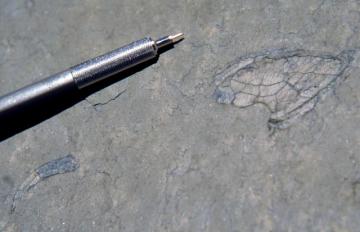The Precambrian/Cambrian boundary appears relatively abruptly when examined from the perspective of large, shelled fossils. However, because a geologic process taking many millions of years may leave behind only a few inches of rock, when geologists say "suddenly" it has a different meaning than the common usage.  Trilobite Fragments: from the Cambrian Andrews Mountain Formation, White-Inyo Mtns., California. Photo by Steven Newton.
Trilobite Fragments: from the Cambrian Andrews Mountain Formation, White-Inyo Mtns., California. Photo by Steven Newton.
Precambrian rocks are usually free of bioturbation, which is the destruction of fine layering by animals burrowing into soft sediment. In rock forming today, sediments are usually bioturbated. The absence of bioturbation indicates something is unusual for example, anoxic conditions, where there is not enough oxygen dissolved in water to sustain life. Today such conditions are rare.
Just prior to the Cambrian/Precambrian boundary, worldwide massive carbonate deposits (limestone, dolomite) heralded the end of "Snowball Earth," a 220 million year period of deep glaciation now called the Cryogenic Period (850-630 Ma). Above these carbonate deposits geologists start to find the signs of complex life: burrowing, bioturbation, shells. Fragments of shelled animals are much more common than whole fossils of the animals themselves.
Peter Ward of the University of Washington beautifully describes the boundary this way:
I kicked an empty pop can with my thick field boots as I walked along the country road near Addy, surrounded by the roadside sandstones, vestiges of that long-ago world. I was walking stratigraphically upward in these sediments; they lie at an angle, tilted about 30 degrees from their original horizontal. As I walked northward along the road I was thus going up through time, into ever higher and thus younger beds of these sandstones. With each step I passed upward through thousands of years of time; with my quarter-mile hike along the road I had traversed several millions of years among these buff-colored sandstones. I was somewhat disappointed. I was training to become a paleontologist and disdained geological phenomena not associated with fossils"I had been lulled by the walk and the endless slabs of sandstone showing nothing but featureless bedding planes. The small slab now in my hands thus elicited no immediate response. I stared with unseeing eyes at the small oblong shell and tossed the rock before the message from my eyes finally burned through into my brain. The small rock followed a beautiful ballistic arc down the talus slope as I realized that I had just seen an unmistakable announcement of life
"I picked up another piece and saw more shells, amid even more wondrous fossils. I saw the heads of large trilobites, looking something like large crabs yet very different, fossils with segments and strange crescent-shaped eyes unlike anything now living. I was surrounded by fossils, sitting atop a teaming graveyard, a joyous assemblage announcing that after 3 billion years skeletonized life had arrived. I was sitting on the base of the Cambrian System, the start of the Paleozoic era, the beginning of the Phanerozoic, the time of life.
Peter Ward, 1991. On Methuselah's Trail: Living Fossils and the Great Extinctions, p. 27
An important caveat here is that the base the Cambrian, at 542 Ma, is not the beginning of life at all. Nor will the Cambrian Radiation occur for another ~7 Ma, at 535 Ma. So what the geologist sees in outcrops the appearance of large, shelled organisms is not the complete story.
